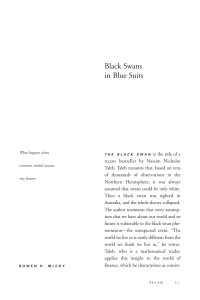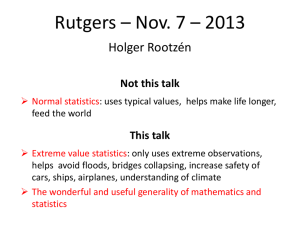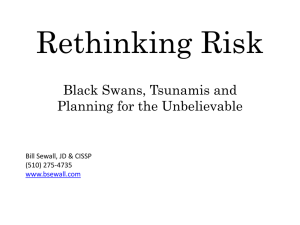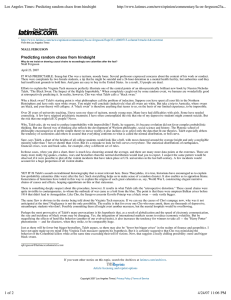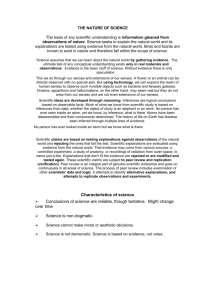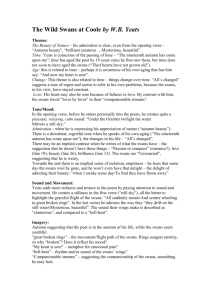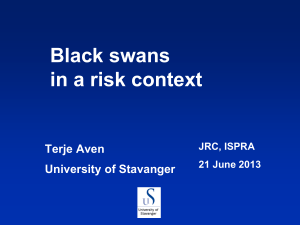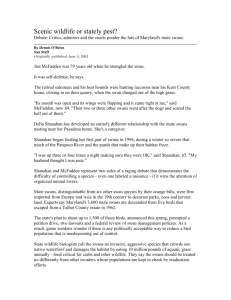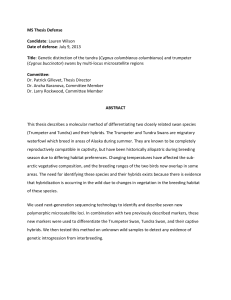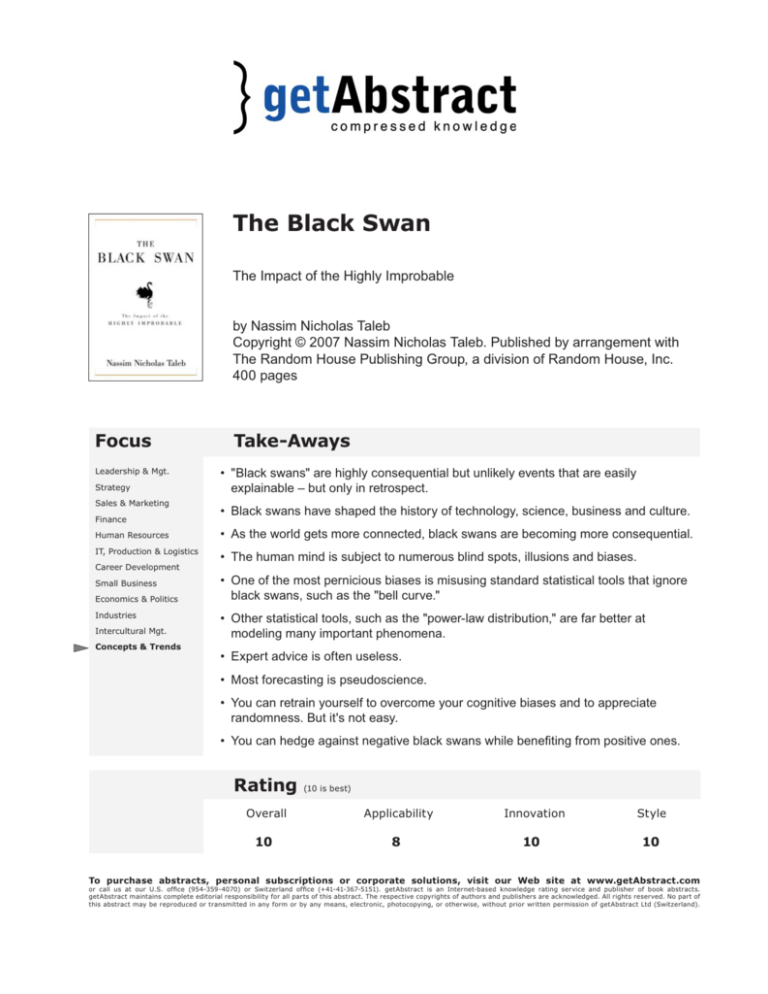
The Black Swan
The Impact of the Highly Improbable
by Nassim Nicholas Taleb
Copyright © 2007 Nassim Nicholas Taleb. Published by arrangement with
The Random House Publishing Group, a division of Random House, Inc.
400 pages
Focus
Leadership & Mgt.
Strategy
Sales & Marketing
Finance
Human Resources
IT, Production & Logistics
Take-Aways
• "Black swans" are highly consequential but unlikely events that are easily
explainable – but only in retrospect.
• Black swans have shaped the history of technology, science, business and culture.
• As the world gets more connected, black swans are becoming more consequential.
• The human mind is subject to numerous blind spots, illusions and biases.
Career Development
Small Business
Economics & Politics
Industries
Intercultural Mgt.
• One of the most pernicious biases is misusing standard statistical tools that ignore
black swans, such as the "bell curve."
• Other statistical tools, such as the "power-law distribution," are far better at
modeling many important phenomena.
Concepts & Trends
• Expert advice is often useless.
• Most forecasting is pseudoscience.
• You can retrain yourself to overcome your cognitive biases and to appreciate
randomness. But it's not easy.
• You can hedge against negative black swans while benefiting from positive ones.
Rating
(10 is best)
Overall
Applicability
Innovation
Style
10
8
10
10
To purchase abstracts, personal subscriptions or corporate solutions, visit our Web site at www.getAbstract.com
or call us at our U.S. office (954-359-4070) or Switzerland office (+41-41-367-5151). getAbstract is an Internet-based knowledge rating service and publisher of book abstracts.
getAbstract maintains complete editorial responsibility for all parts of this abstract. The respective copyrights of authors and publishers are acknowledged. All rights reserved. No part of
this abstract may be reproduced or transmitted in any form or by any means, electronic, photocopying, or otherwise, without prior written permission of getAbstract Ltd (Switzerland).
Relevance
What You Will Learn
In this Abstract, you will learn: 1) Why highly significant yet unpredictable events, called
“black swans,” are underappreciated; 2) Why people continually see misleading patterns
in data; and 3) How to embrace randomness and come to terms with black swans.
Recommendation
According to critic Harold Bloom, Hamlet’s predicament is not “that he thinks too much”
but rather that “he thinks too well,” being ultimately “unable to rest in illusions of any
kind.” The same could be said for philosopher, essayist and trader Nassim Nicholas
Taleb, who finds something rotten in misguided yet supremely confident investment
gurus, traders, hedge fund managers, Wall Street bankers, M.B.A.s, CEOs, Nobelwinning economists and others who claim that they can predict the future and explain the
past. Like everyone else, says Taleb, these so-called “experts” fail to appreciate “black
swans”: highly consequential but unlikely events that render predictions and standard
explanations worse than worthless. Taleb’s style is personal and literary, but his heterodox
insights are rigorous (if sometimes jolted by authorial filigree). This combination makes
for a thrilling, disturbing, contentious and unforgettable book on chance and randomness.
While Taleb offers strong medicine some readers may find too bitter at times, getAbstract
prescribes it to anyone who wants a powerful inoculation against gullibility.
Abstract
“The modern
world…is
dominated by
rare – very
rare – events.”
“We respect what
has happened,
ignoring what
could have
happened.”
“We humans are
an extremely lucky
species, and...we
got the genes of
the risk takers.
The foolish risk
takers, that is.”
When All Swans Were White
Before 1697, teachers confidently taught European schoolchildren that all swans were
white. They had little reason to think otherwise, since every swan ever examined had the
same snowy plumage. But then Dutch explorer Willem de Vlamingh landed in Australia.
Among the many unlikely creatures down under – odd, hopping marsupials called
kangaroos, furry duck-billed platypuses, teddy bear-like koalas – Vlamingh found dark
feathered birds that looked remarkably like swans. Black swans? Indeed. Once observed,
they were as unmistakable as they had been unimaginable, and they forced Europeans to
revise forever their concept of “swan.” In time, black swans came to seem ordinary.
This pattern is common. Just because you haven’t seen a black swan, doesn’t mean that
there are no black swans. Unlikely events seem impossible when they lie in the unknown
or in the future. But after they happen, people assimilate them into their conception of
the world. The extraordinary becomes ordinary, and “experts” such as policy pundits and
market prognosticators kick themselves because they didn’t predict the (now seemingly
obvious) occurrence of the (then) unlikely event. Think of the advent of World Wars I
and II, the terrorist attacks of 9/11, the popping of the 1990s Internet stock bubble, or
world-changing inventions like the internal combustion engine, the personal computer
and the Internet. Cultural fads like the Harry Potter books are the same. These events and
inventions came out of nowhere, yet in hindsight they seem almost inevitable. Why?
The human mind is wonderful at simplifying the onslaught of today’s “booming, buzzing confusion” of data. This makes perfect sense: After all, the brain is the product of
evolution, which works with what it has, and so it has not crafted some new, ideal cognitive mechanism. The human brain is a marvel, but it is built for living in hunter-gatherer
The Black Swan
© Copyright 2007 getAbstract
2 of 5
“We like stories,
we like to
summarize, and
we like to simplify,
i.e., to reduce
the dimension
of matters.”
“Now, I do
not disagree
with those
recommending
the use of a
narrative to get
attention…It is
just that narrative
can be lethal
when used in
the wrong places.”
“Notice that close
to two centuries
ago people had an
idealized opinion
of their own past,
just as we have an
idealized opinion
of today’s past.”
“I know that
history is going
to be dominated
by an improbable
event, I just don’t
know what that
event will be.”
groups on the African savannah 200,000 years ago. Then, it just needed to be good
enough to allow humans to survive until they reached reproductive age. Simplifications,
mental schemas, heuristics, biases, self-deception – these are not “bugs” in the cognitive
system, but useful features that allow the human mind to concentrate on the task at hand
and not get overwhelmed by a literally infinite amount of data. But human simplifying
mechanisms are not without their costs. Take stories, for example.
The Narrative Fallacy
Stories help people remember and make sense of the past. Think of a typical business
magazine profile of a successful businessman. The story begins in the present, after he
has become rich beyond his wildest dreams. The story then cuts back to his humble
beginnings. He started with nothing and wanted to get rich (in terms of story structure,
his “dramatic need”). He faced obstacle after obstacle (perhaps he had a rival – the
“antagonist”). But he made shrewd decisions and flouted the wisdom of the Cassandras
who counseled caution (“Idiots!”). As success built on success, he amassed a fortune. He
retired early, married a model and now has brilliant children who play Chopin blindfolded
and will all attend Ivy League colleges. His virtues will be extolled in a B-School case
study. Wide-eyed M.B.A. students will sit rapt at his feet when he visits their schools on
a lecture tour promoting his latest book. He is a superman, an inspiration.
Now consider an alternative hypothesis: He got lucky. His putative “virtues” had nothing
to do with his success. He is, essentially, a lottery winner. The public looks at his life
and concocts a story about how brilliant he was, when, in fact, he was merely at the right
place at the right time. This is the “ludic fallacy” (ludus means game in Latin): People
underestimate luck in life – though they ironically overestimate it in certain games of
“chance.” Even the businessman himself falls victim to flawed thinking through the selfsampling bias. He looks at himself, a sample of one, and draws a sweeping conclusion,
such as, “If I can do it, anyone can!” Notice that the same reasoning would apply had he
merely bought a winning lottery ticket. “I’m a genius for picking 3293927! Those long
odds didn’t mean a darn thing. I mean, after all, I won didn’t I!”
Not all success is luck. In some professions, skill matters (for example, if you are a dentist),
but luck dominates in others. In the case of the inspiring businessman, consider his
population cohort. Where are all the similarly situated people who started out like him and
have the same attributes? Are they also rich? Or homeless? Usually you can’t find this sort
of “silent” disconfirming evidence. Artistic success provides a perfect illustration. While
Balzac is famous now, perhaps countless other equally talented writers were producing
comparable work at the same time. Yet their writings are lost to posterity because they did
not succeed. Their “failure” hides the evidence that would undercut Balzac’s “success” as
a uniquely great writer. The evidence is silent, lost in the graveyard of history.
The mind uses many more simplifying schemas that can lead to error. Once people have
theories, they seek confirming evidence; this is called “confirmation bias.” They fall
victim to “epistemic arrogance,” becoming overconfident about their ideas and failing to
account for randomness. To make their theories work, people “smooth out” the “jumps”
in a time series or historical sequence, looking for and finding patterns that are not there.
Their conceptual categories will limit what they see; this is called “tunneling.” They turn
to “experts” for help, but often these expert opinions are no better – and often they are
worse – than the “insights” gained from flipping a coin or hiring a trained chimp to throw
darts at the stock listings. Worst of all, people steadily fail to consider “black swans,” the
highly consequential rare events that drive history.
The Black Swan
© Copyright 2007 getAbstract
3 of 5
“Prediction, not
narration, is the
real test of our
understanding
of the world.”
“I find it
scandalous that
in spite of the
empirical record
we continue to
project into the
future as if we
were good at it,
using tools
and methods
that exclude
rare events.”
“What matters
is not how often
you are right, but
how large your
cumulative
errors are.”
“Put yourself
in situations
where favorable
consequences are
much larger than
unfavorable ones.”
“Mediocristan” or “Extremistan?”
So the human mind tends to smooth away the rough features of reality. Does this matter?
It can matter, and a lot, depending on whether you’re in “Mediocristan” or “Extremistan.”
Where are these strange places? Nowhere. They are actually memorable metaphors for
remembering two wildly different classes of natural phenomena. Mediocristan refers
to phenomena you could describe with standard statistical concepts, like the Gaussian
distribution, known as the “bell curve.” Extremistan refers to phenomena where a single,
curve-distorting event or person can radically skew the distribution. Imagine citing Bill
Gates in a comparison of executive incomes.
To understand the difference, think about human height versus movie ticket sales. While
a sample of human beings may contain some very tall people (perhaps someone eight
feet tall) and some very short people (perhaps someone two feet tall), you wouldn’t
find anyone 3,000 feet tall or an inch tall. Nature limits the heights in the sample. Now
consider movie ticket sales. One hit movie can have sales that exceed the median value
by such a radical extent that modeling the sample with a Gaussian curve is misleading
– thereby rendering the notion of “median value” meaningless. You’d be better off using a
different kind of curve for such data, for instance, the “power law” curve from the work
of Vilfredo Pareto (of 80/20 “law” fame). In a power law-modeled distribution, extreme
events are not treated as outliers. In fact, they determine the shape of the curve.
Social phenomena are impossible to model with the Gaussian normal distribution
because these phenomena exhibit “social contagion,” that is, abundant feedback loops.
For instance, one reason you want to see a hit movie is that everyone else has seen it and
is talking about it. It becomes a cultural event that you don’t want to miss. And neither
does anyone else. In these situations, the “rich get richer”: The hit film gets increasingly
popular because of its popularity until some arbitrarily large number of people have seen
it. And speaking of rich, wealth follows this pattern, too. The extremely wealthy are not
just a little bit wealthier than normal rich people; they are so much wealthier that they
skew the distribution. If you and Bill Gates share a cab, the average wealth in the cab can
be north of $25 billion dollars. But the distribution is not bell shaped. When this happens,
odds are you’re no longer in Kansas. You’re in Extremistan.
Phony Forecasting (or Nerds and Herds)
Extremistan might not be so bad if you could predict when outliers would occur and
what their magnitude might be. But no one can do this precisely. Consider hit movies.
Screenwriter William Goldman is famous for describing the “secret” of Hollywood hits:
Nobody can predict one. Similarly, no one knew whether a book by a mother on welfare
about a boy magician with an odd birthmark would flop or make the author a billionaire.
Stock prices are the same way. Anyone who claims to be able to predict the price of a
stock or commodity years in the future is a charlatan. Yet the magazines are filled with
the latest “insider” advice about what the market will do. Ditto for technology. Do you
know what the “next big thing” will be? No. No one does. Prognosticators generally miss
the big important events – the black swans that impel history.
Chalk these errors up to “nerds and herds.” Nerds are people who can only think in terms of
the tools they have been taught to use. When all you have is a hammer, everything becomes
a nail. If all you have is Gaussian curves, sigma (standard deviation), and mild, ordinary
randomness, you’ll see bell curves everywhere and will explain away disconfi rming data
as “outliers,” “noise” or “exogenous shocks.” (The proliferation of Excel spreadsheets
allowing every user to fit a regression line to any messy series of data doesn’t help.)
The Black Swan
© Copyright 2007 getAbstract
4 of 5
“We
misunderstand
the logic of large
deviations from
the norm.”
Further, humans follow the herd and look to “experts” for guidance. Yet, some domains
can’t have experts because the phenomena the expert is supposed to know are inherently
and wildly random. Of course, this discomforting thought requires a palliative, which is to
think that the world is much more orderly and uniform than it often is. This soothing belief
usually serves people well. Then comes a stock market drop or 9/11 (on the downside), or
Star Wars and the Internet (on the upside), and the curve is shot.
Befriending Black Swans
Even given these grim facts, the world need not become, in Hamlet’s words, “a sterile
promontory,” nor need a beautiful sky appear “a foul and pestilent congregation of vapors.”
You can tame, if not befriend, the black swan by cultivating some “epistemic virtues:”
•
•
“Randomness,
in the end, is just
unknowledge. The
world is opaque
and appearances
fool us.”
•
•
•
•
“Every morning
the world appears
to me more
random than it did
the day before,
and humans seem
to be even more
fooled by it than
they were the
previous day.”
•
•
Keep your eyes open for black swans – Look around and realize when you are
in Extremistan rather than Mediocristan. Social contagion and rich-get-richer
phenomena are clues that you’ve just gotten off the bus in Extremistan.
Beliefs are “sticky,” but don’t get glued to them – Revise your beliefs when confronted
with contrary evidence. Dare to say, “I don’t know,” “I was wrong” or “It didn’t work.”
Know where you can be a fool and where you can’t – Are you trying to predict
what sort of birthday cake your daughter wants? Or the price of oil in 17 years after
investing your life’s savings in oil futures? You can’t help being foolish – no one can.
But sometimes foolishness is dangerous, and sometimes it is benign.
Know that in many cases, you cannot know – Think outside your usual, customary
conceptual categories. Eliminate alternatives that you know are wrong rather than
always trying to find out what is right.
As a forecasting period lengthens, prediction errors grow exponentially – Suspend
judgment where evidence is lacking and be wary of overly precise predictions.
“Fuzzy” thinking can be more useful. Often you should focus only on consequences,
not overly precise probabilities.
Expose yourself to “positive black swans” – And, at the same time, hedge against
negative ones. “Bet pennies to win dollars.” Look for asymmetries where favorable
consequences are greater than unfavorable ones. Maximize the possibilities of
serendipity by, say, living in a city, and having a wide circle of diverse friends and
business associates.
Look for the nonobvious – Seek out disconfirming evidence for pet theories. Think,
“What event would refute this theory?” rather than just stacking up confirming
evidence for the sake of consistency, and turning out any evidence that contradicts
your notion. In other words: Amassing confirming evidence doesn’t prove a theory
or a mental model.
Avoid dogmatism – “De-narrate” the past and remember that stories mislead. That’s
the whole point: They are psychological armor against the “slings and arrows of
outrageous fortune.” Think for yourself. Avoid nerds and herds.
This universe, this planet and your life were highly unlikely. But they happened. Enjoy
your good fortune and remember that you are a black swan.
About The Author
Nassim Nicholas Taleb, a former derivatives trader, is Dean’s Professor in the Sciences
of Uncertainty at the University of Massachusetts and teaches at New York University’s
Courant Institute of Mathematical Sciences. He also wrote Fooled by Randomness.”
The Black Swan
© Copyright 2007 getAbstract
5 of 5


